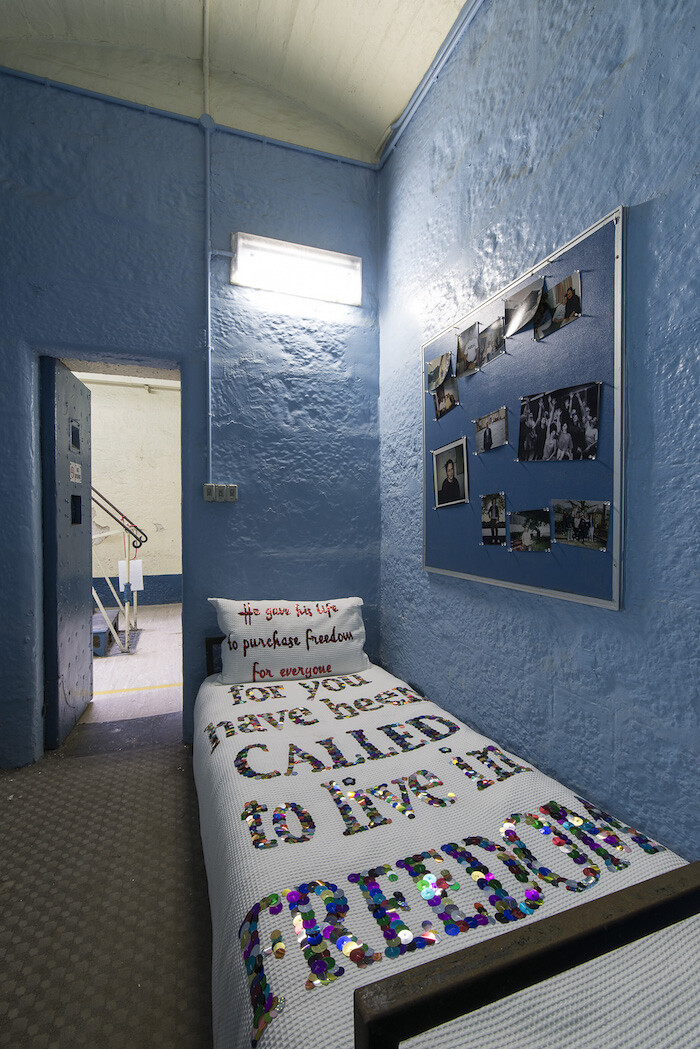The Old Beechworth Gaol, northeast of Melbourne, was founded in 1864, just as the importation of convicts from Britain ceased, but kept its doors open—or rather, shut—until its closure in 2004. The most notorious prisoner in this Jeremy Bentham–inspired panopticon was Ned Kelly, the iconic “bushranger” and gang-leader who killed policemen and famously wore a suit of armor made from stolen plough parts while on the run. It was his mother Ellen’s incarceration in the Beechworth Gaol in 1878, for assaulting a police officer, which led Ned to his last shootout and eventual hanging two years later. Kelly’s life and death have inspired poetry, paintings (such as Sidney Nolan’s famous “Ned Kelly” series, painted 1945–1947), and a 1970 film starring Mick Jagger in the title role.
For Melbourne artist Gabriel Curtin, who grew up in Beechworth, the Kelly mythos is suffocating in its historicity. Throughout the state of Victoria, prison tourism capitalizes on “outlaw chic”—a photo taken of Kelly the day before he was hanged, with perfect coif and full beard, could be a blueprint for contemporary hipsters from Brunswick to Brooklyn—while ignoring the reality of incarceration in Australia today. While white Australians often exhibit a perverse pride in their country’s colonial origins as a penal colony, the country’s Indigenous population are 13 times more likely than other Australians to be locked up, with shocking rates of abuse and death in custody. Meanwhile, illegal detention of refugees and asylum seekers continues on Manus Island and Nauru. It is therefore significant that “A Thousand Times the Rolling Sun,” a group exhibition curated by Curtin and exhibited in the Beechworth Gaol, includes several works by Indigenous artists, even if their work does not explicitly engage with their heritage.
Bindi Cole Chocka is among them. Her EH5452 (2012–2018) is a restaging of a video installation originally commissioned by artist Brook Andrew in 2012. Inside a woman’s cell at the prison, Chocka has covered a bedspread and cushions with phrases picked out in multicolored sequins, one proclaiming “Jesus wept.” A video projection shows the artist in cartoon-style prison garb, reading in a singsong, children’s television style from her own real-life prison diary. Incarcerated as a young woman for drug convictions as the eponymous number EH5452, Chocka’s rehabilitation involved conversion to Christianity, a path she has stayed on ever since. In a white cube gallery, EH5452 would be cloying. In this decrepit cell, it’s a ray of sunshine.
Steven Rhall’s Visibility is a Trap (2018) sees light differently—blinding as much as revealing. In the octagonal observation booth at the heart of the panopticon, local historians have excavated part of the floor, attempting to unearth the graves of prisoners hung on site. Digging in prisons usually indicates escape—but this hole bespeaks introspection, rather than freedom. Rhall lights the whole thing up with fluorescent strips, like a miniature stadium, watching the watchers.
Outside, in the exercise yard, cabbage leaves are neatly laid out to dry in the searing summer heat. Katie West pounds these leaves with pulp to make paper that dries in the sun: blank pages for unwritten histories. West’s collaboration with Fayen D’Evie, The Museum Incognita (2018), sidesteps the dominant mythologies of white Australia to tell “the stories of others”: tales of Chinese indentured labor, market gardeners, and cooks—the overlooked and the unsung. Aesthetics of care reappear in Isadora Vaughan’s Aves (2018), in which pieces of furniture are covered in birdseed. Recalling a recovery program for birds of prey undertaken by prisoners, it also offers a reminder of the normalized imprisonment of animals. Entrapment in one’s own body is inferred by Tara O’Conal’s poetic video Body Hole (2018): slivers of light filtering through closed fingers, projected high onto the window of a mauve-painted cell. Literal poetry is also on offer. Melbourne writer Ender Baskan’s No Body Politic (2018) is a surreal take on Kelly’s literary effort known as the “Jerilderie Letter” (1879), in which he attempts to justify his actions. Superimposing Kelly with Ai Weiwei and Genghis Khan, and the Old Beechworth Gaol with the Great Wall of China, Baskan’s poetic rant is printed to match the length of Kelly’s body and “hung” in the upper cell hall gangway at the exact location of the original gallows site.
Australia’s cities were hewn from local rock by convict labor, but today nineteenth-century prisons have been converted into tourist attractions, cafes, even apartments. Curtin’s curated incursion into the Old Beechworth Gaol doesn’t broadcast these issues, but creates a space in which they surface of their own accord. Significantly, the artist includes artworks by current inmates from the nearest functioning prison, such as R.C.’s REFLECTION (2018), a haunting painting of a feline face behind barbed wire. The next stage of Curtin’s project will take the form of a book, and he has expressed interest in staging similar projects in other institutions, including a local power station and an asylum, while Beechworth locals want another iteration of “A Thousand Times.” Indeed, the Gaol tour I attended provided a curious, if frequently baffled, audience, who spent a long time assimilating and discussing the works. The last lines of Baskan’s poem were a talking point: “a / person who wants to understand / their country is already well on the / way to jail.” In the struggle to understand Manus, Nauru, and Aboriginal Australian incarceration rates and deaths in custody, emerging artists like Curtin and his cohort have taken to the Old Beechworth Gaol, digging for clues.










